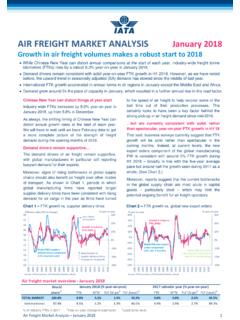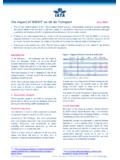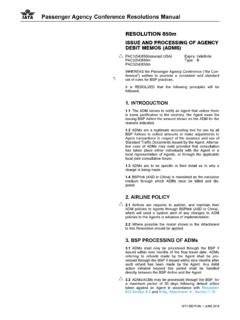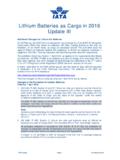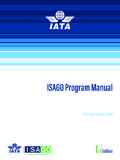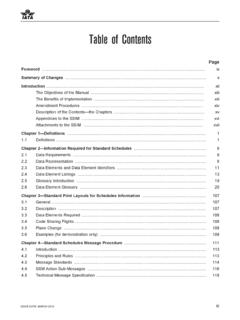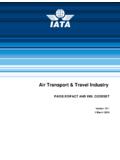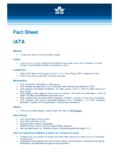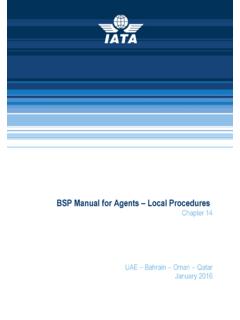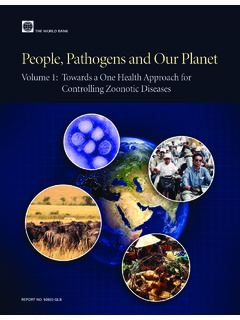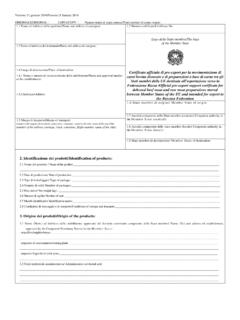Transcription of Dangerous Goods Regulations - IATA
1 Dangerous Goods Classification of Division substances must be classified inSTATE VARIATIONS: AUG 03, CAG 08, VUG 02 Division and assigned to UN 2814, UN 2900,OPERATOR VARIATIONS: 4C 04, 4M 04, BZ 07, CM 05,UN 3291 or UN 3373, as 04, JJ 04, L7 04, LA 07, LP 04, LU 04, M3 04, SN 03, substances are divided into theSQ 10, UC 04, UU 05, XL 04following Category A: An infectious substance which3is transported in a form that, when exposure to it occurs,For the purposes of these Regulations :is capable of causing permanent disability, infectious substancesare substances whichor fatal disease in otherwise healthy humans or known or are reasonably expected to containIndicative examples of substances that meet these criteriapathogens. Pathogens are defined as micro-organismsare given in Table (including bacteria, viruses, rickettsiae, parasites, fungi)Note:and other agents such as prions, which can causeAn exposure occurs when an infectious substance isdisease in humans or outside of the protective packaging, resulting inNote:physical contact with humans or from plant, animal or bacterial sources which do(a) infectious substances meeting these criteria whichnot contain any infectious substances or toxins that arecause disease in humans or both in humans andnot contained in substances which are infectiousanimals must be assigned to UN 2814.
2 Infectioussubstances should be considered for classification insubstances which cause disease only in animalsDivision and assigned to UN be assigned to UN Biological productsare those products(b)Assignment to UN 2814 or UN 2900 must be basedderived from living organisms which are manufacturedon the known medical history and symptoms of theand distributed in accordance with the requirements ofsource human or animal, endemic local conditions, orappropriate national authorities, which may have specialprofessional judgement concerning individual circum-licensing requirements and are used either for prevention,stances of the source human or , or diagnosis of disease in humans or animals,Notes:or for development, experimental or investigational proper shipping name for UN 2814 isposes related thereto.
3 They include, but are not limited to, infectious substance , affecting humans. Thefinished or unfinished products such as shipping name for UN 2900 Culturesare the result of a process by whichsubstance, affecting are intentionally propagated. This following table is not exhaustive. Infectiousdoes not include patient specimens as defined below insubstances, including new or , which do not appear in the table butwhich meet the same criteria must be Patient specimensare those collectedto Category A. In addition, if there is doubt as todirectly from humans or animals, including, but not limitedwhether or not a substance meets the criteria itto, excreta, secreta, blood and its components, tissue andmust be included in Category fluid swabs and body parts being transported forpurposes such as research, diagnosis, the following table, the micro-organismsactivities, disease treatment and in italics are bacteria, mycoplasma,rickettsia or Medical or clinical wastesare wastesderived from the medical treatment of animals or humansor from EDITION, 1 JANUARY 2017168 ClassificationTABLE Examples of infectious Substances Included in Category A inAny Form Unless Otherwise Indicated ( )UN Number and ProperShipping NameMicro-organismUN 2814 Bacillus anthracis(cultures only)
4 infectious substanceBrucella abortus(cultures only)3affecting humansBrucella melitensis(cultures only)Brucella suis(cultures only) mallei Pseudomonas mallei Glanders (cultures only)Burkholderia pseudomallei Pseudomonas pseudomallei(cultures only)Chlamydia psittaci avian strains (cultures only)Clostridium botulinum(cultures only)Coccidioidesimmitis(cultures only)Coxiella burnetii(cultures only)Crimean-Congo haemorrhagic fever virusDengue virus (cultures only)Eastern equine encephalitis virus (cultures only)Escherichia coli, verotoxigenic (cultures only)Ebola virusFlexal virusFrancisellatularensis(cultures only)Guanarito virusHantaan virusHantavirus causing hemorrhagic fever with renal syndromeHendra virusHepatitis B virus (cultures only)Herpes B virus (cultures only)Human immunodeficiency virus (cultures only)Highly pathogenic avian influenza virus (cultures only)Japanese Encephalitis virus (cultures only)Junin virusKyasanur Forest disease virusLassa virusMachupo virusMarburg virusMonkeypox virusMycobacterium tuberculosis(cultures only)Nipah virusOmsk haemorrhagic fever virusPoliovirus (cultures only)Rabies virus (cultures only)Rickettsia prowazekii(cultures only)Rickettsia rickettsii(cultures only)Rift Valley fever virus (cultures only)Russian spring-summer encephalitis virus (cultures only)58th EDITION, 1 JANUARY 2017169 Dangerous Goods RegulationsTABLE Examples of infectious Substances Included in Category A inAny Form Unless Otherwise Indicated ( )(continued)UN Number and ProperShipping NameMicro-organismSabia virusShigella dysenteriae type 1(cultures only)
5 Tick-borne encephalitis virus (cultures only)3 Variola equine encephalitis virus (cultures only)West Nile virus (cultures only)Yellow fever virus (cultures only)Yersinia pestis(cultures only)UN 2900 African swine fever virus (cultures only) infectious substancesAvian paramyxovirus Type 1 Velogenic Newcastle disease virus (cultures only)affecting animalsClassical swine fever virus (cultures only)Foot and mouth disease virus (cultures only)Goatpox virus (cultures only)Lumpy skin disease virus (cultures only)Mycoplasma mycoides Contagious bovine pleuropneumonia (cultures only)Peste des petits ruminants virus (cultures only)Rinderpest virus (cultures only)Sheep-pox virus (cultures only)Swine vesicular disease virus (cultures only)Vesicular stomatitis virus (cultures only) Category B: An infectious substance blood spots, collected by applying adoes not meet the criteria for inclusion in Category of blood onto absorbent material are not subject toInfectious substances in Category B must be assigned tothese occult blood screening samples areNote.
6 Not are not subject to these proper shipping name of UN 3373 or blood components which have beensubstance Category for the purposes of transfusion or for Exceptionspreparation of blood products to be used for transfusionor transplantation and any tissues or organs intended which do not contain infectioususe in transplantation as well as samples drawn insubstances or substances which are unlikely to causeconnection with such purposes are not subject to thesedisease in humans or animals are not subject to unless they meet the criteria for inclusion inanother specimens for which there is minimallikelihood that pathogens are present are not subject containing micro-organisms,other provisions of these Regulations provided:which are non-pathogenic to humans or animals are not(a)The specimen must be packed in a packaging whichsubject to these Regulations unless they meet the criteriawill prevent any leakage and which is marked withfor inclusion in another words Exempt human specimen or in a form that any present patho-animal specimen, as appropriate;gens have been neutralized or inactivated such that they(b)The packaging must consist of three components:no longer pose a health risk are not subject to leak-proof primary receptacle(s); Regulations unless they meet the criteria for inclusion inanother leak-proof secondary packaging.
7 Outer packaging of adequate strength for samples (including food andcapacity, mass and intended use and with atwater samples), which are not considered to pose aleast one surface having minimum dimensions ofsignificant risk of infection are not subject to these100 mm 100 mm; Regulations , unless they meet the criteria for inclusion inanother EDITION, 1 JANUARY 2017170 Classification(c)For liquids, absorbent material in sufficient quantity tocontents. Packagings must be designed to meet theabsorb the entire contents must be placed betweenconstruction requirements listed in primary receptacle(s) and the secondary devices or equipment must being so that, during transport, any release or leak of adrained of free liquid to the extent practicable. They mustliquid substance will not reach the outer packagingbe packed in a strong rigid outer packaging fitted withand will not compromise the integrity of thesufficient cushioning material to prevent movement withincushioning material;the outer packaging.
8 These packagings must meet the(d)When multiple fragile primary receptacles are placedgeneral packing requirements of , ,in a single secondary packaging, they must be and If the outer packaging is notindividually wrapped or separated to prevent contactliquid tight and the medical devices or equipment are3between with or contain liquid infectious substances,(e)If refrigerated or frozen specimens are to be trans-a means of containing the liquid in the event of the following conditions must be met:must be provided in the form of a leakproof liner, plasticbag or other equally effective means of dry ice or liquid nitrogen is used to keepThese packages must be capable of retaining the medicalspecimens cold, all applicable requirements ofdevices and equipment when dropped from a heightthese Regulations must be met.
9 When used, iceof dry ice must be placed between the second-ary packaging and the outer packaging. InteriorNote:supports must be provided to secure the second-A packaging's capability of retaining medical devices orary packaging in the original position after the iceequipment when dropped from a height of m shouldor dry ice has dissipated. If ice is used, thebe determined through testing a sample package asoutside packaging must be leakproof. If carbonprepared for transport or through alternative means suchdioxide, solid (dry ice) is used, the packagingas non-destructive testing and engineering analysis, test-must be designed and constructed to permit theing with an article of similar mass and size, or otherrelease of carbon dioxide gas to prevent a build-equivalent of pressure that could rupture the must be marked Used Medicalings;Device or Used Medical Equipment.
10 When primary receptacle and the secondary pack-are placed in an overpack this mark must be reproducedaging must maintain their integrity at the tem-on the outside of the overpack unless the mark remainsperature of the refrigerant used as well as and the pressures which exception does not apply to:result if refrigeration were lost.(a)medical waste (UN 3291);Note:(b)medical devices or equipment contaminated with orIn determining whether a patient specimen has acontaining infectious substances in Category Aminimal likelihood that pathogens are present, an(UN 2814 or UN 2900); andelement of professional judgment is required todetermine if a substance is exempt under this(c)medical devices or equipment contaminated with orparagraph. That judgment should be based on thecontaining other Dangerous Goods that meet theknown medical history, symptoms and individualdefinition of another hazard of the source, human or animal andendemic local conditions.
